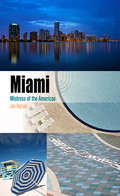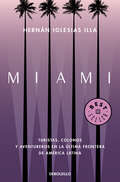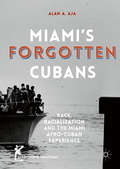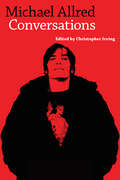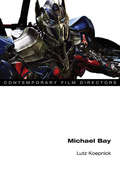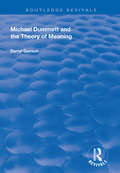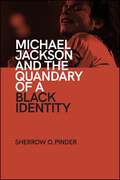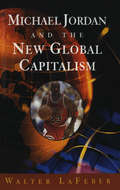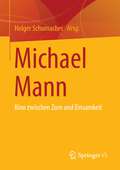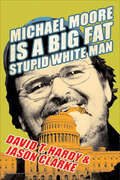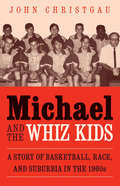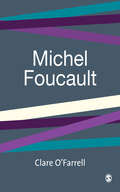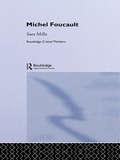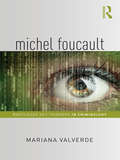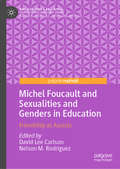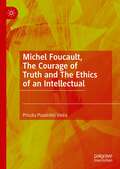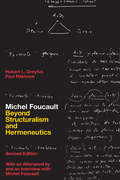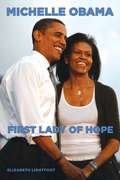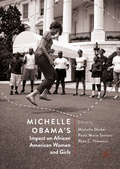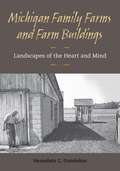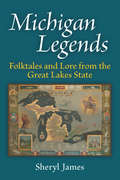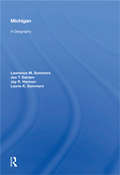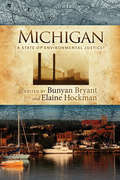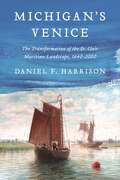- Table View
- List View
Miami: Mistress of the Americas (Metropolitan Portraits)
by Jan NijmanAs a subtropical city and the southernmost metropolitan area in the United States, Miami has always lured both visitors and migrants from throughout the Americas. During its first half-century they came primarily from the American North, then from the Latin South, and eventually from across the hemisphere and beyond. But if Miami's seductive appeal is one half of the story, the other half is that few people have ever ended up staying there. Today, by many measures, Miami is one of the most transient of all major metropolitan areas in America.Miami: Mistress of the Americas tells the story of an urban transformation, perfectly timed to coincide with the surging forces of globalization. Author Jan Nijman connects different historical episodes and geographical regions to illustrate how transience has shaped the city to the present day, from the migrant labor camps in south Miami-Dade to the affluent gated communities along Biscayne Bay. Transience offers opportunities, connecting business flows and creating an ethnically hybrid workforce, and also poses challenges: high mobility and population turnover impede identification of Miami as home.According to Nijman, Miami is "mistress of the Americas" because of its cultural influence and economic dominance at the nexus of north and south. Nijman likens the city itself to a hotel; people check in, go about their business or pleasure, then check out. Locals, born and raised in the area, make up only one-fifth of the population. Exiles, those who have come to Miami as a temporary haven due to political or economic necessity, are typically yearning to return to their homeland. Mobiles, the affluent and well educated, who reside in Miami's most prized neighborhoods, are constantly on the move.As a social laboratory in urban change and human relationships in a high-speed, high-mobility era, Miami raises important questions about identity, citizenship, place-attachment, transnationalism, and cosmopolitanism. As such, it offers an intriguing window onto our global urban future.
Miami: Turistas, colonos y aventureros en la última frontera de América Latina
by Hernán Iglesias IllaHernán Iglesias Illa elude los lugares comunes que ubican a Miami entre la frivolidad y el anticastrismo, y brinda un retrato apasionante de una ciudad amoral y caótica en permanente metamorfosis. Palmeras, flamencos, centros comerciales y exiliados cubanos. Los lugares comunes sobre Miami se desarticulan y dan paso, en este libro de Hernán Iglesias Illa, a una ciudad más visceral, vital y brutal, autodestructiva y fascinante. Las historias de Miami pendulan entre los suburbios y los rascacielos atestados de inmigrantes latinos -colombianos, venezolanos, nicaragüenses, argentinos intermitentes y, claro, anticastristas llegados de "la isla"-, que alteran de manera permanente la fisonomía y la musicalidad de esta ciudad mutante; un universo saturado de relatos urgentes y físicos, espectaculares en su violencia y en su carga emocional, que nos hablan del presente, del pasado reciente y del futuro en un cóctel vertiginoso y embriagador. Acercamiento híbrido y vibrante como el paisaje que describe, Miami es crónica periodística y diario de viaje; es literatura. En sus páginas toma forma un mundo siempre en transición, siempre en el borde; suerte de frontera que interpela y desafía, un espacio de cruce apasionante y salvaje.
Miami’s Forgotten Cubans
by Alan A. AjaAlan A. Aja argues that post-1958 Afro-Cuban reception and adaptation experiences were vastly different than their predominantly "white" co-ethnics in South Florida, much due to processes of race-based social distancing operating within the Cuban-American community.
Michael Allred: Conversations (Conversations with Comic Artists Series)
by Christopher IrvingMichael Allred (b. 1962) stands out for his blend of spiritual and philosophical approaches with an art style reminiscent of 1960s era superhero comics, which creates a mixture of both postmodernism and nostalgia. His childhood came during an era where pop art and camp embraced elements of kitsch and pastiche and introduced them into the lexicon of popular culture. Allred's use of both in his work as a cartoonist on his signature comic book Madman in the early 1990s offset the veiled autobiography of his own spiritual journey through Mormonism and struggles with existentialism. Thematically, Allred's work deals heavily with the afterlife as his creations struggle with the grander questions—whether his modern Frankenstein hero Madman, cosmic rock 'n' roller Red Rocket 7, the undead heroine of iZombie (co-created with writer Chris Roberson), or the cast of superhero team book The Atomics. Allred also enjoys a position in the creator-driven generation that informs the current batch of independent cartoonists and has experienced his own brush with a major Hollywood studio's aborted film adaptation of Madman. Allred's other brushes with Hollywood include an independent adaptation of his comic book The G-Men from Hell, an appearance as himself in Kevin Smith's romantic comedy Chasing Amy (where he provided illustrations for a fictitious comic book), the television adaptation of iZombie, and an ongoing relationship with director Robert Rodriguez on a future Madman film. Michael Allred: Conversations features several interviews with the cartoonist from the early days of Madman's success through to his current mainstream work for Marvel Comics. To read them is to not only witness the ever-changing state of the comic book industry, but also to document Allred's growth as a creative genius.
Michael Bay (Contemporary Film Directors)
by Lutz KoepnickIf size counts for anything, Michael Bay towers over his contemporaries. His summer-defining event films involve extraordinary production costs and churn enormous box office returns. His ability to mastermind breathtaking spectacles of action, mayhem, and special effects continually push the movie industry as much as the medium of film toward new frontiers. Lutz Koepnick engages the bigness of works like Armageddon and the Transformers movies to explore essential questions of contemporary filmmaking and culture. Combining close analysis and theoretical reflection, Koepnick shows how Bay's films, knowingly or not, address profound issues about what it means to live in the late twentieth- and early twenty-first centuries. According to Koepnick's astute readings, no one eager to understand the state of cinema today can ignore Bay's work. Bay's cinema of world-making and transnational reach not only exemplifies interlocking processes of cultural and economic globalization. It urges us to contemplate the future of moving images, of memory, matter, community, and experience, amid a time of rampant political populism and ever-accelerating technological change. An eye-opening look at one of Hollywood's most polarizing directors, Michael Bay illuminates what energizes the films of this cinematic and cultural force.
Michael Dummett and the Theory of Meaning (Routledge Revivals)
by Darryl GunsonPublished in 1998, this book argues that in recent decades, Anglo-American philosophy of language has been captivated by the idea that the key to progress in this area of philosophy lies in investigating the possibility of constructing a theory of meaning. This text provides an in-depth critique of the Davidsonian suggestion that Tarski's work on formal definitions of truth is an important element in allowing us to understand the form that the theory of meaning should take.
Michael Jackson and the Quandary of a Black Identity (SUNY series in African American Studies)
by Sherrow O. PinderIn Michael Jackson and the Quandary of a Black Identity, Sherrow O. Pinder explores the ways in which the late singer's racial identification process problematizes conceptualizations of race and the presentation of blackness that reduces blacks to a bodily mark. Pinder is particularly interested in how Michael Jackson simultaneously performs his racial identity and posits it against strict binary racial definitions, neither black nor white. While Jackson's self-fashioning deconstructs and challenges the corporeal notions of "natural bodies" and fixed identities, negative readings of the King of Pop fuel epithets such as "weird" or "freak," subjecting him to a form of antagonism that denies the black body its self-determination. Thus, for Jackson, racial identification becomes a deeply ambivalent process, which leads to the fragmentation of his identity into plural identities. Pinder shows how Jackson as a racialized subject is discursively confined to a "third space," a liminal space of ambivalence.
Michael Jordan and the New Global Capitalism (New Edition)
by Walter LafeberWalter LaFeber's timely analysis looks at the ways that triumphant capitalism, coupled with high-tech telecommunications, is conquering the nations of the world, one mind--one pair of feet--at a time. With Michael Jordan and the New Global Capitalism, Walter LaFeber has written a biography, a social history, and a far-ranging economic critique. From basketball prodigy to international phenomenon to seductive commercial ideal, Michael Jordan is the supreme example of how American corporations have used technology in a brave, massively wired new world to sell their products in every corner of the globe. LaFeber's examination of Nike and its particular dominion over the global marketplace is often scathing, while his fascinating mini-biography of Michael Jordan and the commercial history of basketball reveal much about American society. For this new paperback edition, LaFeber has added a chapter on globalization in a changed world, after mass protests and since September 11. "Bold, riveting....Brilliantly illuminates how hyper-US capitalism has spread its financial wings around the globe."--Douglas Brinkley "LaFeber brings an impressive intellect to bear on his subject."--Barbara Rudolph, Chicago Tribune
Michael Mann: Kino zwischen Zorn und Einsamkeit
by Holger SchumacherZum ersten Mal widmen sich zehn deutschsprachige Wissenschaftler mit unterschiedlichen Forschungsschwerpunkten dem Gesamtwerk Michael Manns. Dabei werden die Leser*innen zu einer zweifachen Reise eingeladen: Auf einem faszinierenden Tauchgang in die Filmwelt des gefeierten Regisseurs treten zentrale Themen, Figurenkonstellationen, kulturelle Hintergründe und Wirkungseinheiten zutage, die einen völlig neuen Blick auf seine Kunst eröffnen: Wie schafft es Michael Mann seit mehr als 40 Jahren, ein weltweites Publikum zu fesseln und immer wieder aufs Neue in den Kinosaal zu locken? Was verraten seine Filme dadurch über die unbewussten Sehnsüchte, Obsessionen und Widerstände in unserer Kultur? Gleichzeitig entwickelt sich ein spannender Dialog zwischen den verschiedenen Deutungsansätzen: Anhand populärer Kinofilme wie HEAT oder COLLATERAL wecken die wichtigsten Disziplinen - von der Morphologie bis zur Seduktionstheorie - Neugier auf den Facettenreichtum der deutschsprachigen Filmwissenschaft. Auf diese Weise entsteht ein Buch über die Kunst des Films und seiner Interpretation.
Michael Moore Is a Big Fat Stupid White Man
by David T. Hardy Jason ClarkeWatching Michael Moore in action—passing off manipulating facts in Bowling for Columbine, spinning statistics in Stupid White Men and Dude, Where's My Country?, shamelessly grandstanding at the Academy Awards, and epitomizing the hypocrisy he's made a king's fortune railing against—has spurred authors David T. Hardy and Jason Clarke to take action into their own hands. In Michael Moore Is a Big Fat Stupid White Man, Hardy and Clarke dish it back hard to the fervent prophet of the far left, turning a careful eye on Moore's use of camera tricks and publicity ploys to present his own version of the truth.Postwar documentarians gave us the documentary, Rob Reiner gave us the mockumentary, and Moore initiated a third genre, the crockumentary.How, they ask, does Moore pull off a proletarian, "man-of-the-people" image so at odds with his lifestyle as a fabulously wealthy Manhattanite? And how large of an impact do his incendiary, ill-founded polemics have on the growing community that follows him with near-religious devotion? Loaded with well-researched, solidly reasoned arguments, and laced with irreverent wit, Michael Moore Is a Big Fat Stupid White Man fires back at one of the left's biggest targets—politically and literally.
Michael and the Whiz Kids: A Story of Basketball, Race, and Suburbia in the 1960s
by John ChristgauImagine a boy, five feet tall and one hundred pounds, who wants to play high school basketball. Now imagine that he was blind until the age of six and that he’s the first black student to attend his suburban school. And there you have Michael Thompson in 1965 in San Bruno, California. He played at the school where a young English teacher was coaching “lightweight basketball,” a competition for smaller players that has since disappeared. The team that Coach John Christgau put together came to be called the Whiz Kids for the way they rocketed up and down the court, led by Michael and invariably winning.Michael and the Whiz Kids tells the story of the team’s 1968 championship season. It is a tale of cliffhanger games and players as outsized in character as they are short in stature, from the wild-haired, bespectacled “Professor” to the well-traveled Latvian dubbed “Suitcase” to the quiet and tenacious “Salt,” as in “of the earth.” But it is also a tale of the time—of counterculture, suburbia, integration, and racial brawls erupting on the court. In Christgau’s deft telling, it is an absorbing, often comic story of coming of age, for coach and Whiz Kids alike.
Michel Foucault
by Clare O'Farrell"A truly magnificent book... If there is a more comprehensive book on Foucault's work I have yet to see it. I anticipate those teaching and taking courses on Foucault's work will find Clare O'Farrell's book to be an invaluable resource." - Barry Smart, University of Portsmouth "A marvellous introduction... This volume captures the penetrating interdisciplinary concerns that have made Foucault a guide to so many beyond the frontiers of philosophy and history, beyond the borders of the academic community itself... O'Farrell reveals Foucault as he is: the engaged moralist who survived the twentieth century's systems of total explanation. This is an excellent introduction for the general reader to a passionate mind that continues to spread its influence." - James Bernauer, Boston College "Offers the best introduction to Foucault's philosophy... Superb glossary of major terms; excellent bibliography and chronology. Summing Up: Essential. Upper-level undergraduates through faculty/researchers." - C.E. Reagan, Kansas State University, CHOICE Michel Foucault's work is one of the most influential sources of ideas in the humanities and social sciences today. Clare O'Farrell offers a comprehensive and accessible introduction to Foucault's enormous, diverse and challenging output. Her book provides a range of practical tools and a reference work for readers who wish to understand and apply his ideas at both introductory and advanced levels. This volume includes: A discussion of Foucault's situation in the contemporary context exploring his role as an iconic thinker, with clear explanations as to why his work is so difficult to come to grips with, and also importantly, why it is of interest to so many people. The location of Foucault's work within its own historical, social and political setting. Brief summaries in chronological order of all of Foucault's major works, including the more recently published volumes of lectures. The organization of Foucault's work around five interrelated assumptions which underpin his world view: namely order, history, truth, power and ethics. Ideas for which he is well-known, such as archaeology, genealogy, discourse, discipline, and governmentality are discussed within the framework of these. A chronology of Foucault's life, work and times. An extensive list of key concepts in Foucault's work with detailed references pointing to where the relevant material can be found in his writings. A wide-ranging list of resources and a bibliography of Foucault's work for easy consultation.
Michel Foucault (Routledge Critical Thinkers)
by Sara MillsIt is impossible to imagine contemporary critical theory without the work of Michel Foucault. His radical reworkings of the concepts of power, knowledge, discourse and identity have influenced the widest possible range of theories and impacted upon disciplinary fields from literary studies to anthropology. Aimed at students approaching Foucault's texts for the first time, this volume offers:* an examination of Foucault's contexts* a guide to his key ideas* an overview of responses to his work* practical hints on 'using Foucault'* an annotated guide to his most influential works* suggestions for further reading.Challenging not just what we think but how we think, Foucault's work remains the subject of heated debate. Sara Mills' Michel Foucault offers an introduction to both the ideas and the debate, fully equipping student readers for an encounter with this most influential of thinkers.
Michel Foucault (Routledge Key Thinkers in Criminology)
by Mariana ValverdeThis book explores the theoretical contribution of Michel Foucault to the fields of criminology, law, justice and penology. It surveys both the ways in which the work of Foucault has been applied in criminology, but also how his work can be used to understand and explain contemporary issues and policies. Moreover, this book seeks to dispel some of the common misconceptions about the relevance of Foucault’s work to criminology and law. Mariana Valverde clearly explains the insights that Foucault’s rich body of work provides about different practices found in the fields of law, security, justice, and punishment; and how these insights have been used or could be used to understand and explain issues and policies that Foucault himself did not write about, including those that had not yet emerged during his lifetime. Drawing on key texts by Foucault such as Discipline and Punish, and also lectures he gave at the College de France and Louvain Criminology Institute which offer a more nuanced account of the development of criminal justice, Mariana Valverde offers the essential text on Foucault and his contribution and continued relevance to criminology. This book will be important reading for students and scholars of criminology, law, sociolegal studies, security studies, political theory and sociological theory.
Michel Foucault and Sexualities and Genders in Education: Friendship as Ascesis (Queer Studies and Education)
by Nelson M. Rodriguez David Lee CarlsonThis book examines, within the context and concerns of education, Foucault’s reflections on friendship in his 1981 interview “Friendship as a Way of Life.” In the interview, Foucault advances the notion of a homosexual ascesis based on experimental friendships, proposing that homosexuality can provide the conditions for inventing new relational forms that can engender a homosexual culture and ethics, “a way of life,” not resembling institutionalized codes for relating. The contributors to this volume draw from Foucault’s reflections on ascesis and friendship in order to consider a range of topics and issues related to critical studies of sexualities and genders in education. Collectively, the chapters open a dialogue for researchers, scholars, and educators interested in exploring the importance and relevance of Foucault’s reflections on friendship for studies of schooling and education.
Michel Foucault, The Courage of Truth and The Ethics of an Intellectual
by Priscila Piazentini VieiraThe relationship between two distinct periods in Michel Foucault's work is the starting point for this book. In "Truth and Power," an interview Foucault gave in 1976, he states that to create a new politics of truth is an intellectual's main task. In this book, Priscila Piazentini Vieira analyzes Foucault's study on ancient culture and courage of truth in the 1980s as his main contribution to our construction of a new politics of truth, much diverse from modernity's prevailing understanding of it grounded on the will to knowledge. Furthermore, she analyzes Foucault's militant practice and his GIP experience from a corpus constructed by papers, courses, interviews, and books written by the philosopher between the 1970s and 1980s. By clearly linking Foucault’s work on to his own militant activity, the book also aims to develop an original definition of the intellectual at the crossroad of political engagement, the production of knowledge, and the manifestation of the truth.
Michel Foucault: Beyond Structuralism and Hermeneutics
by Hubert L. Dreyfus Paul RainbowThis book, which Foucault himself has judged accurate, is the first to provide a sustained, coherent analysis of Foucault's work as a whole. To demonstrate the sense in which Foucault's work is beyond structuralism and hermeneutics, the authors unfold a careful, analytical exposition of his oeuvre. They argue that during the of Foucault's work became a sustained and largely successful effort to develop a new method—"interpretative analytics"—capable fo explaining both the logic of structuralism's claim to be an objective science and the apparent validity of the hermeneutical counterclaim that the human sciences can proceed only by understanding the deepest meaning of the subject and his tradition. "There are many new secondary sources [on Foucault]. None surpass the book by Hubert Dreyfus and Paul Rabinow. . . . The American paperback edition contains Foucault's 'On the Genealogy of Ethics,' a lucid interview that is now our best source for seeing how he construed the whole project of the history of sexuality."—David Hoy, London Review of Books
Michelle Obama: First Lady of Hope
by Elizabeth LightfootFrom Lady Bird Johnson's highway beautification initiative to Jacqueline Kennedy's White House renovation to Barbara Bush's literacy project - and let's not forget Nancy Reagan's "Just Say No" program - first ladies have captivated and enthralled the voting public for 200 years. Michelle Obama has played an influential role in her husband's campaign, and is certain to do the same during his presidency. Michelle Obama: First Lady of Hope examines, for the first time, her astonishing career - from her undergraduate years at Princeton, where she majored in African Studies, to her studies at Harvard Law School, where she obtained a Juris Doctor degree. This fascinating book will further address her influence on her husband, her role in his presidential campaign, and her political beliefs. Michelle Obama is sure to be one of the most intriguing and influential First Ladies in history. She first met Barack Obama when she was asked to serve as his mentor at a prestigious Chicago law firm. She and Barack were the only African-Americans. The couple married in 1992. She is her husband's closest advisor. A Chicago native, she has attracted much media attention for her candor and frankness. This trait will serve her well in the White House, where no move or statement goes unnoticed.
Michelle Obama’s Impact on African American Women and Girls
by Michelle Duster Paula Marie Seniors Rose C. TheveninThis edited collection explores how First Lady Michelle Obama gradually expanded and broadened her role by engaging in social, political and economic activities which directly and indirectly impacted the lives of the American people, especially young women and girls. The volume responds to the various representations of Michelle Obama and how the language and images used to depict her either affirmed, offended, represented or misrepresented her and its authors. It is an interdisciplinary evaluation by African American women and girls of the First Lady’s overall impact through several media, including original artwork and poetry. It also examines her political activities during and post-election 2016.
Michigan
by Macmillan McGraw-HillThis book is organized to help you understand and apply social studies content and skills as you read. The Big Ideas in this textbook are important ideas in social studies. They will help you understand each unit and its Michigan Standards.
Michigan Family Farms and Farm Buildings: Landscapes of the Heart and Mind
by Hemalata C. Dandekar"Thoughtfully documenting the voice and emotions of many who might otherwise remain unheard, Hemalata Dandekar provides in-depth accounts and insights, underpinned by quietly rigorous analysis, about family interactions and the perceptions, understandings, and memories of family members . . . a tribute to the indomitability of the human spirit as an enduring force in sustaining farm life on the Michigan farms. " ---Anatole Senkevitch, Jr. , Taubman College of Architecture and Urban Planning, University of Michigan Michigan's family farms form the backbone of the state. One need only see the Centennial Farm signs that dot the sides of the state's country roads to understand that. Hemalata Dandekar shows in her new book just how connected those family farm buildings are to the families that inhabit them. Fifteen family-farm case studies display farm buildings' relationship to the land they sit on, their function on the farm, the materials they're made with, the farm enterprises themselves, and the families who own them. Photographs, plans, elevations, and sections of typical, exemplary traditional farm buildings show the aesthetic and architectural qualities of those types of buildings across the state. The ways in which the buildings serve the productive activities of the farm, shelter and nourish the people and livestock, yield a living, and enable the aspirations of farm people are shown in the words and photographs of the farmers themselves. The buildings form a window into the lives of Michigan's family farms and into the hearts and minds of the people who have lived and worked in them their entire lives. Hemalata C. Dandekar is Department Head of City and Regional Planning at California Polytechnic State University. She specializes in urbanization, urban-rural linkages, rural development, and gender and housing. She developed her love of Michigan farmers and farm architecture during her years as a student and professor at the Urban Planning program of the A. Alfred Taubman College of Architecture and Urban Planning at the University of Michigan. She was Director for the Center for South and Southeast Asian Studies and Associate Vice President for Research at the University of Michigan.
Michigan Legends: Folktales and Lore from the Great Lakes State
by Sheryl JamesOver the course of its history, the state of Michigan has produced its share of folktales and lore. Many are familiar with the Ojibwa legend of Sleeping Bear Dunes, and most have heard a yarn or two told of Michigan's herculean lumberjack, Paul Bunyan. But what about Detroit's Nain Rouge, the red-eyed imp they say bedeviled the city's earliest residents? Or Le Griffon, the Great Lakes' original ghost ship that some believe haunts the waters to this day? Or the Bloodstoppers, Upper Peninsula folk who've been known to halt a wound's bleeding with a simple touch thanks to their magic healing powers? In Michigan Legends, Sheryl James collects these and more stories of the legendary people, events, and places from Michigan's real and imaginary past. Set in a range of historical time periods and locales as well as featuring a collage of ethnic traditions--including Native American, French, English, African American, and Finnish--these tales are a vivid sample of the state's rich cultural heritage. This book will appeal to all Michiganders and anyone else interested in good folktales, myths, legends, or lore.
Michigan: A Geography
by Lawrence M. SommersMichigan is truly a "Great Lake State": the two peninsulas, many islands, and 3,100 miles of shoreline on four of the Great Lakes give the state a unique location and a diverse physical environment. The natural landscape is largely the result of erosion and deposition of surface materials during the Great Ice Age. Glacial ridges alternate with till plains and lake bottoms to give Michigan a varied topography and great contrasts in soil fertility. The book, through the use of text, photographs, and maps (drawn especially for this volume by Sherman Hollander), stresses the relationships between this varied natural resource base and the economic, social, and political geography of Michigan. Emphasis is placed on the demographic character, the historical background, and the natural and human resources that have led to Michigan becoming one of the principal manufacturing states in the United States. The book also looks at agriculture and recreation and tourism, which, along with manufacturing, are the major bases of the state's economic development. The regional coverage focuses on the urban dominance of Detroit. This comprehensive overview of Michigan geography closes with an analysis of some of the major quality of life issues in the state and a short glimpse into the future.
Michigan: A State of Environmental Justice?
by Bunyan Bryant and Elaine HockmanMichigan: A State of Environmental Justice? focuses attention on the byproducts of growth and development in the state of Michigan and describes who wins and who loses. Over the years while growth and development have been good for some, it has been devastating for others; the byproducts of growth and development have threatened the lives of people who breathe polluted air, who are exposed to contaminated water, and whose children play on polluted soil. People affected by toxins must organize to protect themselves, their families, and their communities from environmental harm. Let us be clear right from the beginning. We are not against economic growth and development; we are against certain kinds of economic growth and development--i.e., growth and development that expose people to unnecessary harm. We feel it is possible to have economic growth and development with environmental protection. All of this is explored in Michigan: A State of Environmental Justice?
Michigan’s Venice: The Transformation of the St. Clair Maritime Landscape, 1640–2000
by Daniel F. HarrisonFew maritime landscapes in the Great Lakes remain so deeply and clearly inscribed by successive cultures as the St. Clair system—a river, delta, and lake found between Lake Huron and the Detroit River. The St. Clair River and its environs are an age-old transportation nexus of land and water routes, a strategic point of access to maritime resources, and, in many ways, a natural impediment to the navigation of the Great Lakes. From Indigenous peoples and European colonizers to the modern nations of Canada and the United States, this work traces the region’s transformation through culturally driven practices and artifacts of shipbuilding, navigation, place naming, and mapmaking. In this novel approach to maritime landscape archaeology, author Daniel F. Harrison unifies historiography, linguistics, ethnohistory, geography, and literature through the analysis of primary sources, material culture, and ecological and geographic data in a technique he calls "evidence-based storytelling." Viewed over time, the region forms a microcosm of the interplay of environment, culture, and technology that characterized the gradual shift from nature to an industrial society and a built environment optimized for global waterborne transport.
